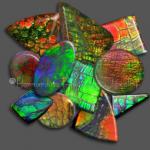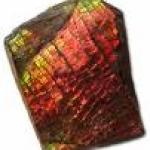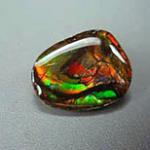
Classes- Alabama
- Alaska
- Arizona
- Arkansas
- California
- Colorado
- Connecticut
- Delaware
- Florida
- Georgia
- Hawaii
- Idaho
- Illinois
- Indiana
- Iowa
- Kansas
- Kentucky
- Louisiana
- Maine
- Maryland
- Massachusetts
- Michigan
- Minnesota
- Mississippi
- Missouri
- Montana
- Nebraska
- Nevada
- New Hampshire
- New Jersey
- New Mexico
- New York
- North Carolina
- North Dakota
- Ohio
- Oklahoma
- Oregon
- Pennsylvania
- Rhode Island
- Tennessee
- Texas
- Utah
- Vermont
- Virginia
- Washington
- West Virginia
- Wisconsin
- Wyoming
| Structure : Orthorhombic Hardness : 4 Specific Gravity : 2.8 Refractive index : 1.52 - 1.6 Ammolite is an opal-like organic gemstone made of the fossilized shells of ammonites, ancient sea creatures whose shells are composed primarily of aragonite. Ammolite is a very fine and soft gem material. The opal like color display is caused by the reflection of light rebounding through layers of aragonite that make up the shell. The more common reds and greens are reflected through the thicker layers and the blues and violets come from the thinner, more fragile and elusive layers. When found, the material is dull, and has to be polished to show the color play. Being that the material is so soft (hardness of 4), it is generally cut as a cabochon, and topped with a layer of spinel or quartz, to increase durability. These are called doublets (2 layers) and triplets (3 layers), both of which are commonly applied to opals. However, Ammolite does not require the moisture that opals need to keep from cracking. Korite International mines Ammolite commercially on the Kainah Reserve in the Alberta province, Canada. This deposit stretches south along the eastern side of the Rocky mountains into Montana, USA. The mining is started by backhoes creating shallow open pits, with the material being sifted and sorted for commercial grade materials. People then move through the pits, examining the contents for more commercial grade material that may have been missed. Korite International is responsible for 90 percent of the worlds Ammolite production, though roughly 5% of the material mined is actually suitable for jewelry. The ammolite deposits range in depth, from 15 meters to 30 meters. In most instances, the depth can indicate the quality of the ammolite. The most common and least valuable material (reds and greens) is recovered at a depth of 15 meters. Material from 20 to 65 meters down is rarely recovered, even though this is the much less fractured and more valuable blue and violet ammolite material. Gemstone quality The quality of Ammolite is determined through looking at a myriad of factors including: colors present, color proportions, color play, and the overall brightness of those colors. It is generally graded as AA, A+, A, and A-, though it is not a highly utilized grading system. Remember that red and green are fairly common colors in Ammolite, but blue and violet are fairly rare, and hard to acquire. Ammolite specimens with three or more colors or 1 or 2 bright and even colors are the most desirable and valuable. Color Play **Chromatic shift is how colors vary with the angle of viewing and the angle of light striking the gemstone; in higher grade Ammolite this variation is almost prismatic in its scope, showing spectral color play. Rotational range is how far the specimen can be turned while maintaining its play of color; the best rotate 360 degrees uncompromised, while intermediate grades have ranges of 240–180°, and lesser stones may exhibit a narrow rotational range down to 90° or less.** Brightness of colors The brightness of colors and their iridescence is dependent on how well-preserved the shell is, how the layers of aragonite are arranged, the quality of the polish, and the thickness of the outer layer after the polish. Treatments Ammolite, being very soft and delicate, is commonly impregnated with a resin to help stabilize the material and keep it from crazing. Korite International and the Alberta Research Council developed this process, which aided in making the material available for world markets as a gemstone. Most Ammolite gemstones have had some sort of treatment, being a doublet or triplet. However, there are some rare specimens which require only cutting and polishing. As with most gemstones, buyers should be aware of all treatments a stone receives before purchasing. Imitations Novice buyers may sometimes confuse Labradorite, with its flashes of blue and green, for Ammolite. In fact, Ammolite is very rarely imitated, even though it is often used as an imitation for Black Opal, which is much more valuable. Uses Ammolite is soft and fragile, and is best used in jewelry like pendants, earrings, and brooches, which are not prone to abrasions or random blows. Ammolite has been on the world market since 1969, so it is a relative newcomer. The stone also has a role in the modern practice of Feng Shui, the belief that the placement and arrangement of ones immediate environment will lead to a prosperous life in harmony. It is believed that the stone enhances a person's chi, and allows a detoxification of the body. Feng Shui practicers seek ammolite stones bearing ruby red for growth, emerald green for wisdom, and amber yellow for wealth. The Blackfeet know the stone as Iniskim or Buffalo Stone, and believe it has healing powers, and that it aids in buffalo hunting. CleaningClean with mild soap and water. Ultrasonic and steam cleaners should be avoided. With proper care, an ammolite stone will last indefinitely. |
- Birth Stone Gems
- Wedding & Anniversary Gems
- How To Guides
- Fireable Gems
- Nonprofits and Guilds
- Gem Show
- Gem Stone Information
- ·Abalone
- ·Achroite (Tourmaline)
- ·Agate ( Chalcedony)
- ·Alexandrite
- ·Almandine ( Garnet )
- ·Amber
- ·Amethyst ( Quartz)
- ·Ammolite
- ·Andalusite
- ·Andradite Garnet
- ·Apatite
- ·Aquamarine ( Beryl )
- ·Aventurine ( Quartz )
- ·Azurite
- ·Benitoite
- ·Bloodstone ( Chalcedony )
- ·Brown Quartz ( Smokey Quartz )
- ·Calcite
- ·Carnelian ( Chalcedony )
- ·Cassiterite
- ·Celestine
- ·Cerussite
- ·Chalcedony
- ·Chatoyant Quartz
- ·Chrysoberyl
- ·Chrysocolla
- ·Chrysoprase (Chalcedony)
- ·Citrine ( Quartz )
- ·Coral
- ·Danburite
- ·Diamond
- ·Diopside
- ·Dioptase
- ·Dravite ( Tourmaline)
- ·Emerald ( Beryl )
- ·Enstatite
- ·Epidote
- ·Euclase
- ·Fire Agate (Chalcedony)
- ·Fluorite
- ·Gold
- ·Goshenite (Beryl)
- ·Grossular Garnet (Tsavorite Garnet)
- ·Gypsum
- ·Heliodor ( Beryl )
- ·Hematite
- ·Hessonite (Grossular Garnet)
- ·Imperial Topaz
- ·Indicolite ( Tourmaline)
- ·Iolite
- ·Ivory
- ·Jadeite
- ·Jasper (Chalcedony)
- ·Jet
- ·Kornerupine
- ·Kunzite
- ·Kyanite
- ·Labradorite
- ·Lapis Lazuli ( Lazurite)
- ·Lazulite
- ·Malachite
- ·Meerschaum
- ·Microcline
- ·Milky Quartz
- ·Moonstone
- ·Morganite ( Beryl)
- ·Nephrite ( Jade)
- ·Obsidian
- ·Oligoclase
- ·Onyx
- ·Opal
- ·Orthoclase
- ·Padparasha ( Corundum)
- ·Pearl
- ·Peridot
- ·Pink Topaz ( Mercury Myst Vapor )
- ·Plasma ( Chalcedony)
- ·Prase ( Chalcedony )
- ·Prehnite
- ·Pyrite
- ·Pyrope ( Garnet )
- ·Rock Crystal ( Quartz )
- ·Rubellite ( Tourmaline)
- ·Ruby ( Corundum)
- ·Sapphire ( Corundum)
- ·Sardonyx ( Chalcedony)
- ·Scapolite
- ·Schorl (Tourmaline)
- ·Shell
- ·Spessarite (Garnet)
- ·Sphalerite
- ·Spinel
- ·Spodumene (Hiddenite - Triphane)
- ·Tanzanite (Zoisite)
- ·Tektites ( Moldavite )
- ·Tiger Eye
- ·Titanite (Sphene)
- ·Topaz
- ·Turquoise
- ·YAG (Garnet)
- ·Zircon


